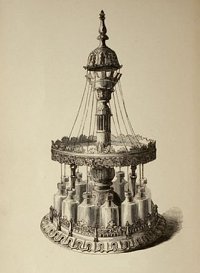
Naturalist George Merryweather offered a gruesome new instrument at London’s Great Exhibition in 1851: He imprisoned 12 leeches in a ring of bottles, which he capped with whalebone levers. (The bottles were arranged in a circle so that the leeches “might see one another and not endure the affliction of solitary confinement.”) When a storm approached, the agitated leeches would climb the bottles, trip the levers, and ring a bell. The more agitated this “jury of philosophical councilors,” the more frequently the bell sounded, and the more likely a storm.
After a year of experiments, Merryweather claimed great success — among other feats, the “leech barometer” foretold the disastrous storm of October 1850 51 hours before it took place. “I may here observe,” Merryweather wrote, “that I could cause a little leech, governed by its instinct, to ring Saint Paul’s great bell in London as a signal for an approaching storm.”
He proposed that the government install stations around the British coast, and nominated engineer William Reid to be inspector-general of leeches and meteorologist James Glaisher his second-in-command. Inexplicably, they turned him down. “After this,” opined Chambers’ Journal, “the Snail Telegraph looks not quite so outrageous an absurdity.”
